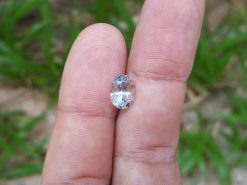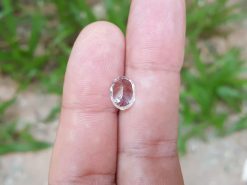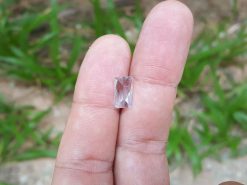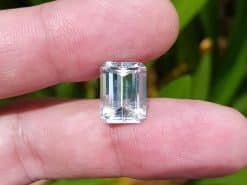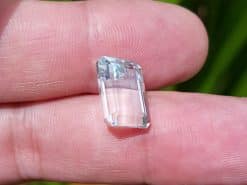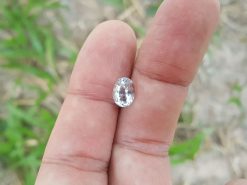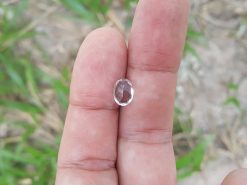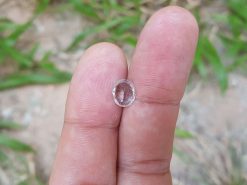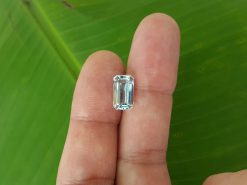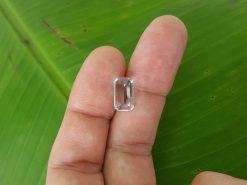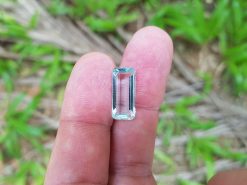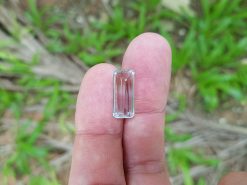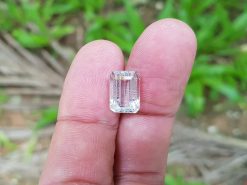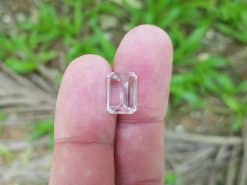Aquamarine

Aquamarine stone is a blue variety of beryl. As the March birthstone, aquamarine gemstone is used in jewelry as rings, necklaces, earrings…
Buy natural aquamarine in our shop
Aquamarine gemstone
It occurs at most localities which yield ordinary beryl. The gem-gravel placer deposits of Sri Lanka contain stones. Chrysolite aquamarine is a green-yellow stone, occurring in Brazil. Maxixe is a deep blue version of beryl gemstone, commonly found in the country of Madagascar. Its color fades to white under sunlight.
What makes aquamarine blue?
It can also fade because of heat treatment. The color can returns with irradiation treatment. The pale blue color of the stone is attributed to Fe2+. Fe3+ ions produce golden-yellow color, and when both Fe2+ and Fe3+ are present. The color is a darker blue as in maxixe.
Discoloration of maxixe by light or heat thus may be due to the charge transfer between Fe3+ and Fe2+. Dark-blue maxixe color can be produced in green, also pink or yellow beryl by irradiating it with high-energy particles. Gamma rays, also neutrons or even X-rays.
Beryl
The chemical composition of Beryl is beryllium aluminum cyclosilicate with the chemical formula Be3Al2(SiO3)6. Similarly, well-known varieties of beryl include emerald, also aquamarine, heliodor, and morganite. Naturally occurring, hexagonal crystals of beryl can be up to several meters in size.
Terminated crystals are relatively rare. Pure stone is colorless, the color is due to inclusions. Possible colors are green, blue, yellow, red (the rarest), and white. It is also an ore source of beryllium.
Beryl belongs to the hexagonal crystal system. Normally it forms hexagonal columns but can also occur in massive habits. As a cyclosilicate it incorporates rings of silicate tetrahedra that are arranged in columns along the C axis and as parallel layers perpendicular to the C axis, forming channels along the C axis.
These channels incorporate a variety of ions, neutral atoms, and molecules into the crystal. Thus disrupting the overall charge of the crystal permitting further substitutions in aluminum, Silicon, and Beryllium sites in the crystal structure. The variety of colors comes from impurities. Increasing alkali content within the silicate ring channels causes increases to the refractive indices and birefringence.
Aquamarine meaning and properties
The following section is pseudo scientific and based on cultural beliefs.
A stone of courage. Its calming energies reduce stress and quiet the mind. the stone has an affinity with sensitive people. It can invoke tolerance of others and overcomes judgmentalism, giving support to those overwhelmed by responsibility.
Aquamarine birthstone
The March birthstone, has a rich color and has long been a symbol of youth, health and hope. Its mesmerizing color ranges from pale to deep blue and are reminiscent of the sea.
Aquamarine under microscope
To see also:
Cat’s eye aquamarine, and blue beryl irradiated
FAQ
Is an aquamarine a precious stone?
It is semi precious. Today some semi precious gemstones can be worth much more than a precious stone.
Does aquamarine have a special meaning?
The gemstone is associated with tranquility, serenity, clarity, and harmony. As the first of the spring birthstones, the sea blue crystal represents transformation and rebirth. It embodies youthful vitality, purity, loyalty, hope, and truth.
What is the best quality aquamarine?
The gem’s most valuable color is a dark blue to slightly greenish blue with moderately strong intensity. In general, the purer and more intense the blue color, the more valuable the stone. Most stone color is a light greenish blue.
What power does aquamarine have?
It is a stone of courage. Its calming energies reduce stress and quiet the mind. The gemstone has an affinity with sensitive people. It can invoke tolerance of others and overcomes judgmentalism, giving support to those overwhelmed by responsibility.
Can you wear aquamarine everyday?
With its icy blue color, displays a magical aura. With a good hardness, this sea-blue gemstone is a very good choice for daily wear. Whether it is an official or a casual event, one can never go wrong with this gem.
What chakra is aquamarine good for?
Along with opening and activating the heart chakra, the energy center associated with unconditional love and compassion, it also supports physical healing. By stimulating the throat chakra, the gem helps to enhance immunity by opening the flow between the heart and the throat energy centers.
What does aquamarine do spiritually?
Often considered a gateway crystal to spiritual access, The stone can help you achieve a closer connection with the outer manifestations of your spirituality and with your inner self.
What can aquamarine be used for?
It is calming, soothing, and cleansing, and inspires truth, trust and letting go. In ancient lore, it was believed to be the treasure of mermaids, and was used by sailors as a talisman of good luck, fearlessness and protection. It was also considered a stone of eternal youth and happiness.
How do you keep aquamarine shiny?
Because of its light color, the stone can get dirty or cloudy when you wear the ring. Cleaning your stone often can keep it beautiful and shining. To clean your aquamarine engagement ring or earrings, wash it with warm soapy water and avoid doing anything that will damage the stone.
What is the best cut for aquamarine stone?
The most popular cut is the rectangle octagon emerald shape. Many jewelry professionals believe square or rectangle cuts complement the stone best. Princess and pear are also preferred.
What does it mean if your birthstone is aquamarine?
March. In ancient times, people believed the traditional birthstone of March, protected seafarers in helping them clearly remember their loved ones when they were far away at sea. Wearing the stone promotes creativity, hope, self-expression and courage.
Are aquamarines rare?
Why does it cost so much more than blue topaz that’s almost the same color? Blue topaz is more common because the color is produced by treating colorless topaz with radiation. It is rarer in nature, especially in fine color. Its long history as a gem also adds to its collectability.
What does an aquamarine engagement ring mean?
It is not only the March birthstone, but is the gem designated to be given for the 19th wedding anniversary. The stone is believed to symbolize health, courage, and clear communication, all things that are important in any marriage, which may account for their popularity in engagement rings.
How long does aquamarine last?
In fact, lighter varieties can even be mistaken for diamonds. However, its Mohs’ Scale rating of 7.5 to 8 indicates that, with extreme wear, it may show signs of scratching over time. Yet, with proper care and servicing, this lovely sea-green gem will last a lifetime.
Which is more expensive aquamarine or topaz?
Blue beryl is generally much more expensive than blue topaz, with the main reason being that blue topaz is artificially heated whereas it is natural in color. However, a ring is almost double the price of the blue topaz ring.
How do you clean aquamarine rings?
The easiest method of care for your stones is to wash them in warm, soapy water: Fill a small bowl with warm water and add a small amount of dish soap. Let your jewelry soak for several minutes and then use a soft bristled toothbrush in order to clean the stone.
What is a lab created aquamarine?
Lab created stones are synthetic. If you have wished to own jewelry containing a natural gemstone but found it too expensive, you can enjoy the beauty of the stone by buying synthetic aquamarine at a fraction of the cost of natural gem.
Natural aquamarine for sale in our gem shop
We make custom made aquamarine jewelry as engagement rings, necklaces, stud earrings, bracelets, pendants… Please contact us for a quote.

